Belle - 2013
'09 maps for:
Bea
--
Buck -- Caley --
Claws --
Conomo --
Hix --
Hudson 09 -- Isabel --
Katy -- L.R. --
Moffet --
Mr. Hannah --
Ozzie --
Penelope
--
Rafael
2010 maps for: Belle
-- Buck --
Gunny --
Hudson --
Mr. Hannah --
Neale --
North Fork Bob
--
Penelope --
Sanford
-- Sr. Bones --
Thatch
2011 maps:
Belle --
Buck --
Henrietta --
Katbird
-- North Fork Bob --
Pemi --
Saco --
Sanford --
Sr. Bones --
Snowy --
Thatch -- Tucker
2012 maps: Art --
Belle --
Bridger --
Chip --
Cutch --
Jill -- North Fork Bob --
Rammie --
Snowy --
Sr. Bones -- Thatch
2013 maps: Art -- Belle --
Bridger -- DJ --
Donovan -- Edwin --
Icarius --
Mackenzie -- Nick --
North Fork Bob --
Quin -- Rammie --
Rodney -- Ron --
Snowy --
Sr. Bones -- Tango --
Woody
Osprey
main page --
Migration
page --
Migration09 --
Migration10 --
Migration 11 --
Migration 12 --
Migration 13 -- Home
Page
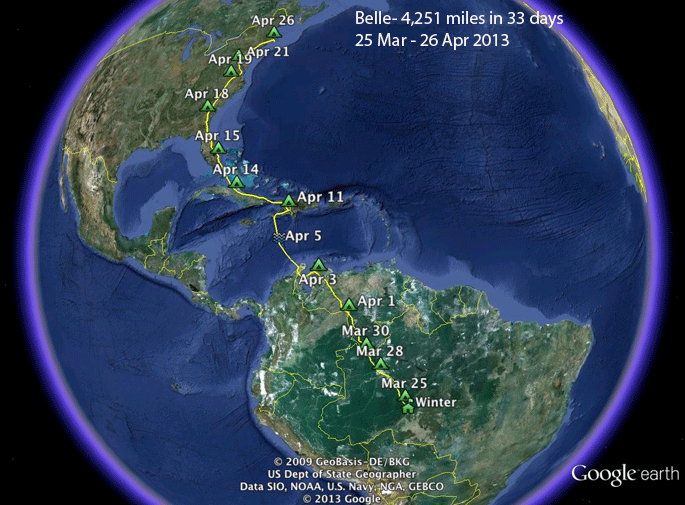 |
25 Mar- 26 Apr 2013 -
Belle got going on 25 Mar and was all about
migrating. 10 days later she pitched her tent on
the Guajira Peninsula in northeastern Colombia.
Her roost-to-roost distance traveled during this
period was 1,578 miles (2,540 km). She averaged
143 miles (231 km) per day, which is pretty
typical. She made it across the Caribbean without a hitch (spring crossings are so much safer!) and then settled down on a large, somewhat saline lake in Haiti. She spent 6 days there, just like last year, and then zipped through Cuba. She made a huge move (370 miles) in a single day crossing much of South and North Carolina before roosting in Virginia on the 19th. She paused for a couple of days near Annapolis--while I was tagging an adult male )Woody) just 20 miles away!--and then finished her migration when she got back to Cape Cod on the 26th. Her roost-to-roost distance traveled was 4,251 miles (6,841 km). She averaged 170 miles (274 km) per day on days she was migrating. You know the routine: Scroll down for more. |
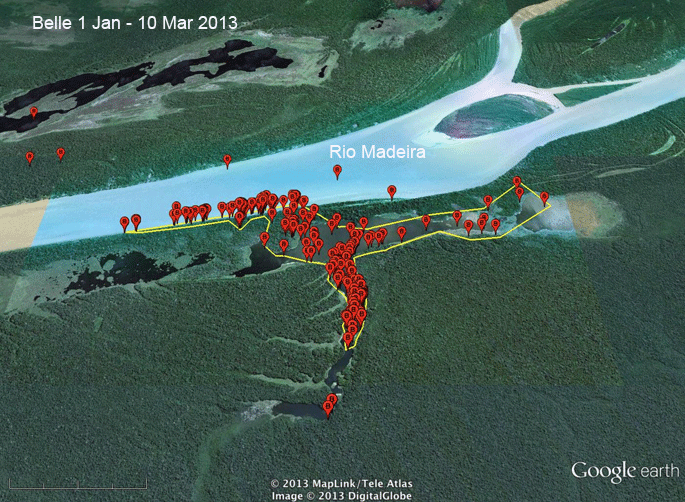 |
On the wintering waters: Jan-Mar 2013 - Belle seems to be finding all the fish she needs in these small lakes alongside the Rio Madeira. She's acting like an adult this winter, restricting her activity to a very restricted area. The core area outlined here in yellow is only 1.8 square miles (4.8 km^2). |
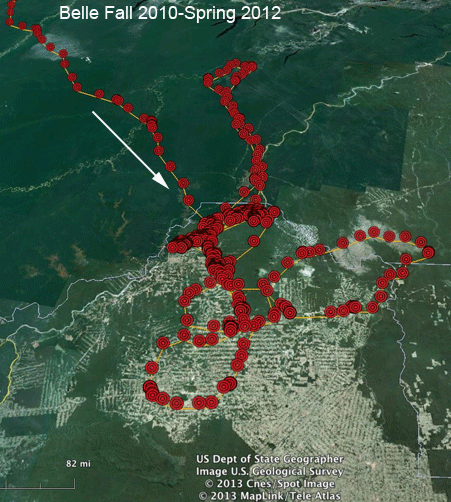 |
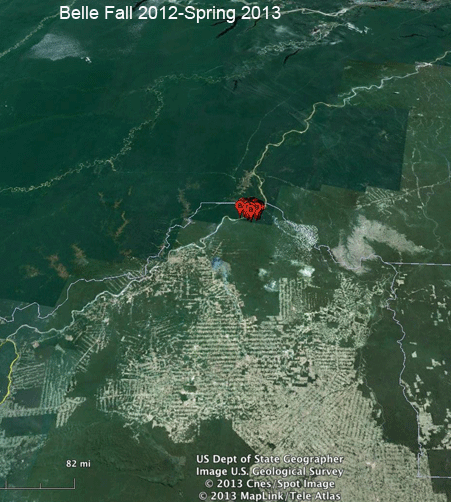 |
|
| Here's the main reason that adult mortality is so much lower than juvenile mortality. The map on the left shows all the ground that juvenile Belle covered once she settled down in southern Amazonia. She was clearly in the real estate market. During her second winter (map on the right) we see that she has barely moved all winter. She still has a month or so to go before heading north, but it's a safe bet that she won't move much until it's time to head north. (When am I going to learn not to make such bold predictions? I know, I know--never. Hey, I did say it's a safe bet--not a sure thing!) | ||
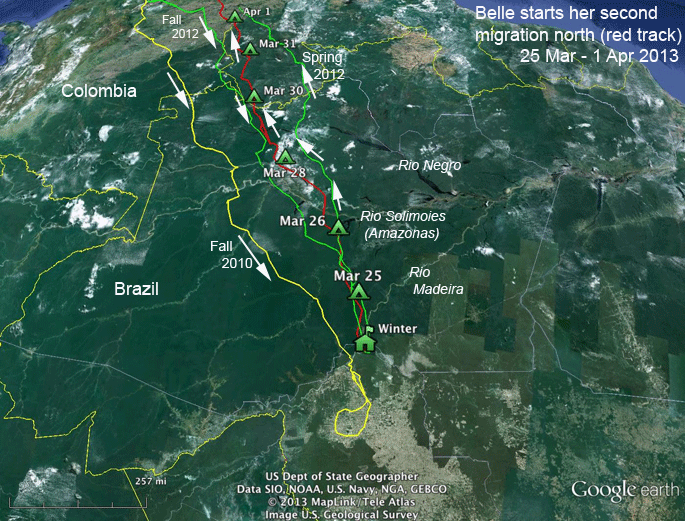 |
Migration begins: 25 Mar-1 Apr 2013 - Belle surprised us a bit when she left for home in March. Other young, even on their second trip north (we've only had a few do this) left later. Last spring, on her first migration, after 18 months in South America, she left for home on April 13. So this year she was 3 weeks ahead of last year's schedule. On this rather busy map, we can see her first trip south (yellow), back in fall of 2010 and some of the wandering she did as she searched for a suitable wintering spot (yellow track). Her two trips in 2012 are in green. |
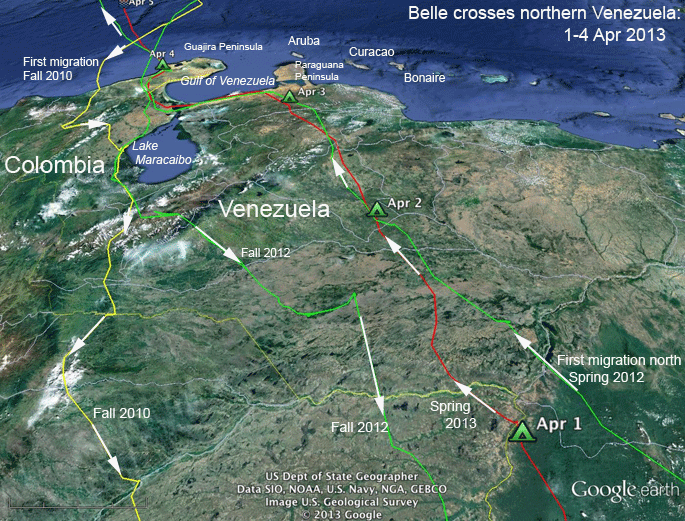 |
Apr 2013 - By the time Belle got up to northern Venezuela she was pretty much retracing her route north from the year before. |
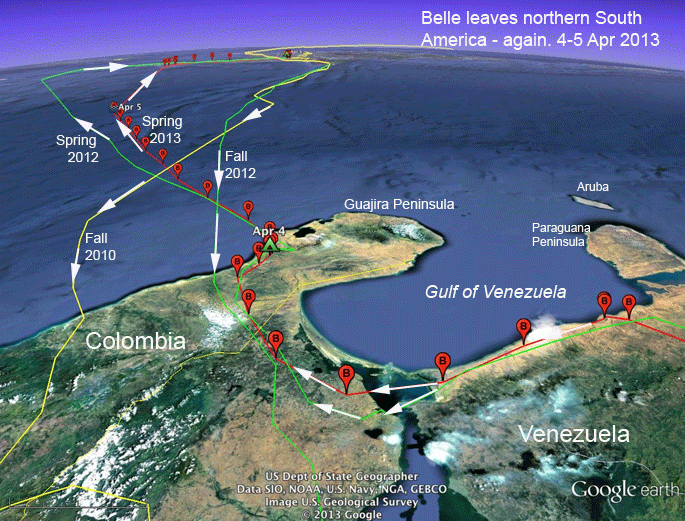 |
Apr 2013 -
Before getting to her launch spot on the Guajira
Peninsula, Belle skirted the Gulf of Venezuela.
She could have gone up to the Paragauna
Peninsula on the Venezuelan side of the Gulf,
but perhaps she had some magnetic memory of
arrivals and departures further west of where
she was when she got to the shores of the Gulf. She took off, almost exactly where she did back in 2012, around 8:30 AM. The dark body of water just east of where she took off is Baia Hondita, where our first juvenile to make it to South America (Jaws) settled down for his first 18 months on the "wintering" waters. |
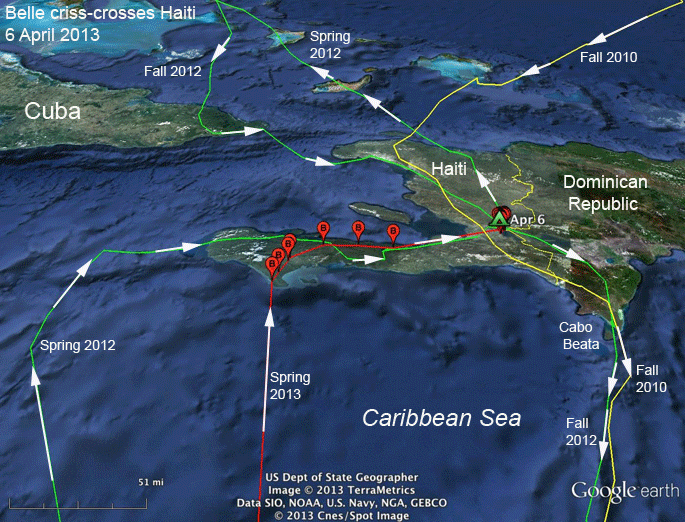 |
Apr 2013 -
Belle got to Haiti probably sometime after 2 AM
on the 6th. The crossing was at least 450 miles
(720 km). She had about 210 miles to go to get
to Haiti from her last GPS fix over the
Caribbean on the 5th. She was flying an average
of 28 mph out over the water while her GPS unit
was on, which is just what we expect. After a bit of rest, she took right off and headed to Lake Saumâtre, where she spent some time last spring on her first trip north. She must have had fond memories of the fish there because she made a real bee-line to get there and then settled down for some serious mid-trip refueling. |
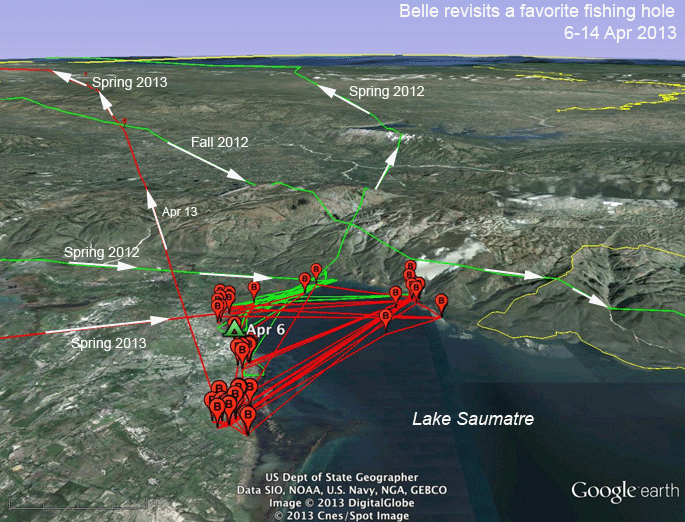 |
6-13 Apr 2013 -
Belle is back at Lake Saumâtre, where she spent
9 days (30 Apr-8 May) on her way north last
year. The green tracks show her movement in the
spring and fall of 2012. Lake Saumâtre is the second largest lake in Haiti, "sister" lake to Lake Enriquillo. Both are situated in a rift valley that was once a marine strait when sea levels were higher. They are below sea level, and thus have no outlet. Consequently, they're both saline. For some reason Saumâtre is slightly saline, while Enriquillo is very salty. The two lakes can fuse in years of exceptional rainfall. Saumâtre is one of the last refuges of the endangered American Crocodile. Wikipedia states that the important raptor species at the lake include Ospreys. I suspect that's mostly during migration, but there may be wintering birds there. Belle gave us quite a scare last spring here. Her transmitter stopped moving for more than 24 hours, leaving me convinced that she was dead. Somehow (a little voodoo perhaps involved) she was resurrected. No similar drama this year, although we did wonder when she was going to get going. She spent 8 days fishing the lake this spring. |
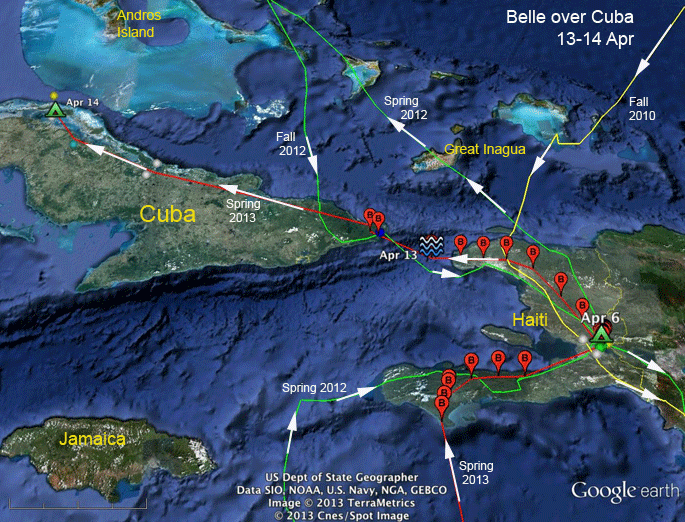 |
13-14 Apr 2013 - We can really see how she is learning the migration route that all adults use as we follow her over these two migration cycles. This will be more evident in the larger scale map below. |
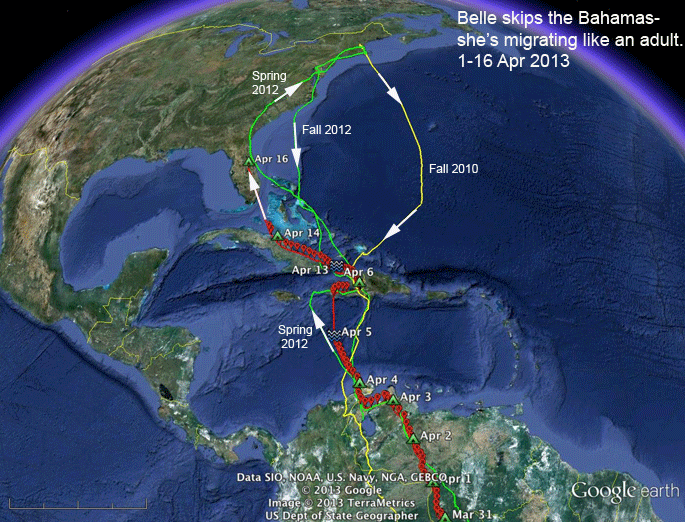 |
4-16 Apr 2013 -
We can see Belle refine her route over the
years. Her first trip south was based on the
simple instinct telling her to go south as the
day length shortened. She almost made it to
Bermuda before getting nudged (probably) by the
Trade Winds towards the Bahamas. When she got to Haiti on her first trip north in 2012, She saw the Bahamas stretched out to the north, so she island hopped her way to northern Florida and then followed the coast up to New England. Having gone up the coast from Florida, she knew that she could get south without taking on 1,000+ miles of the open Atlantic, so her second trip south followed the coast as far as Cape Fear in North Carolina. From there she headed out over the Atlantic, as do many adults who come down the Outer Banks. Rather than heading for the FL coast though, as the adults do, she went due south to the Bahamas and picked up her trail from the spring. Now on her second trip north, she got to Cuba and stayed over the island until she was south of Florida. If all goes well (which from this point forward means avoiding sleeping in woodlots with hungry Great-horned Owls), I suspect in the fall we'll see her stay over the coast and get all the way down to the Florida Keys. At that point we'll give her a diploma for successfully completing her graduate studies in Osprey Migration. It's all trial and error. Using the simplest of user manuals--"head south (fall) or north (spring) and stay over land if possible"--she has discovered the route that all adult Ospreys follow. How cool is that? |
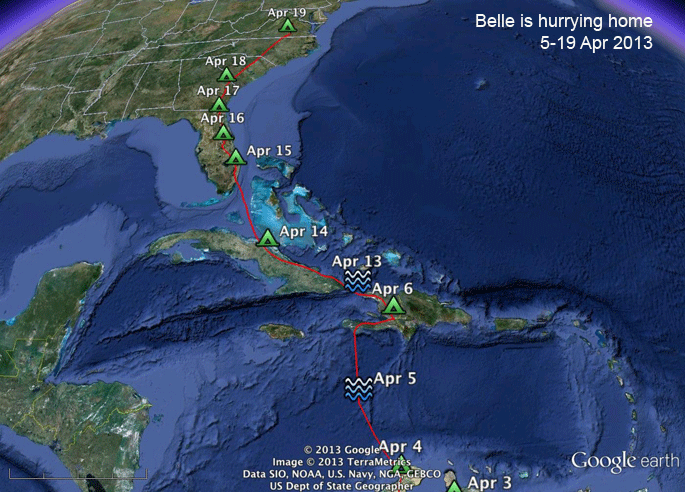 |
4-19 Apr 2013 -
Belle is not messing around! After her week for
refueling at Lake Saumatre down in Haiti, she
took care of Cuba in pretty much a single day's
flight. She moved along at an average pace for
three days after getting to Florida. Then on
April 19th the afterburners kicked in, and she
covered 370 miles in a single day! There was a
big front moving in, so she had some powerful
tailwinds. She should be home in two or three days. So, will she go back to the Vineyard where she spent most of her first summer back in North America, or over to Cape Cod, where she settled down for the last month before starting her second migration back in the fall of 2012? |
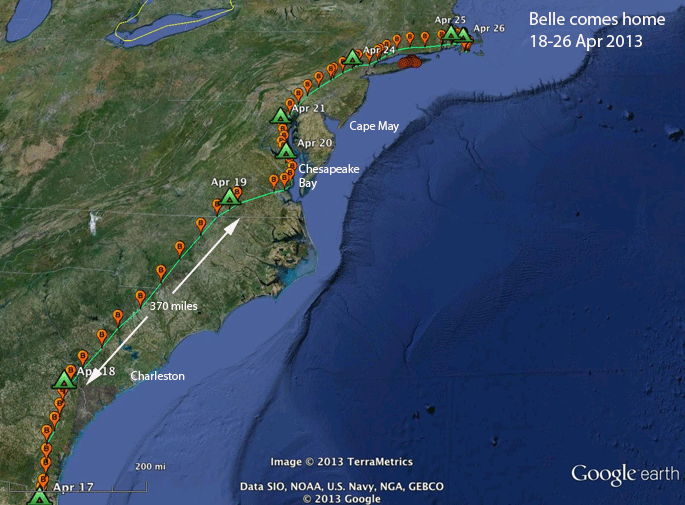 |
18-26 Apr 2013 - Belle took a couple of days off when she got close to Annapolis, but then got back on track and made it home on the 26th. |
 |
4-19 Apr 2013 - Belle got back to the Cape at 10 AM on the 26th. Last year she spent the last month of her first summer back home on Cape Cod, right where the northernmost cluster of of points is on this map. |
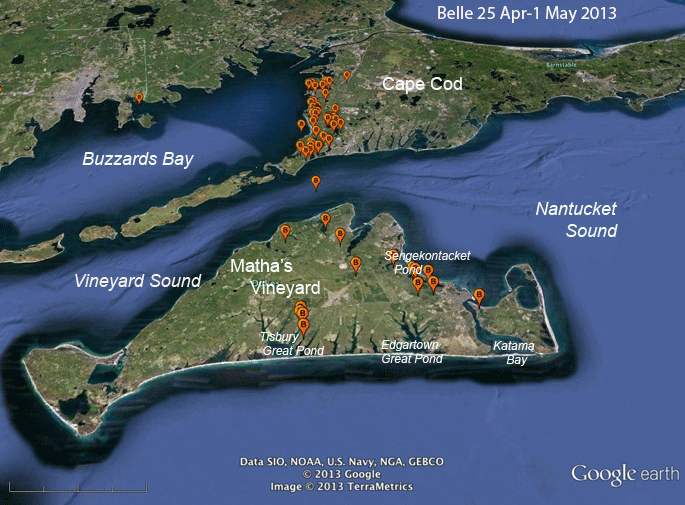 |
25 Apr-1 May 2013 - In the next few maps, we'll look at her locations week by week. In the first week back, she spent most of her time on Cape Cod. |
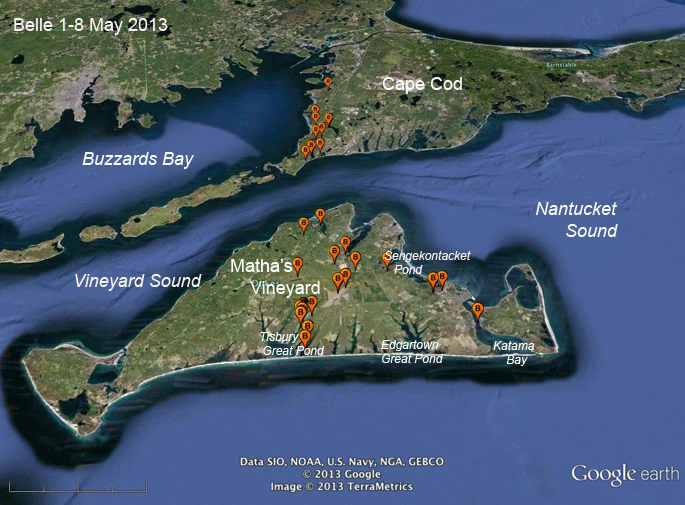 |
1-8 May 2013 - In week 2, Belle continues to commute, but is spending a lot of time around Tisbury Great Pond, where she spent most of last summer after her first migration home last year. |
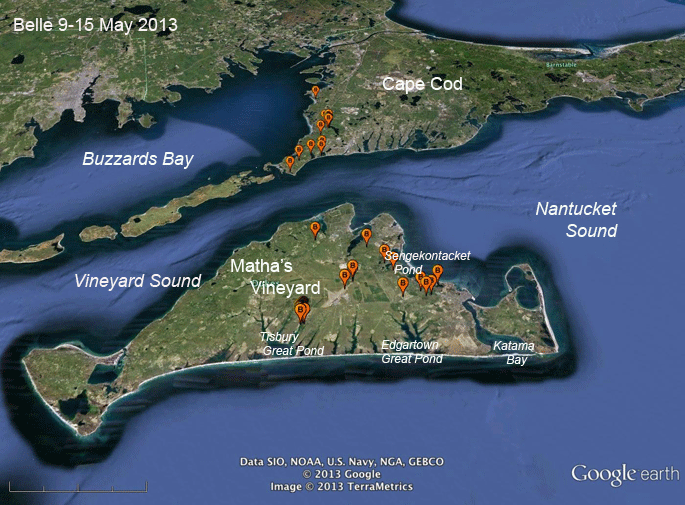 |
9-15 May 2013 -
Belle is spending most of her time on the
Vineyard, and she's really focused in on Tisbury
Great Pond's Deep Bottom Cove. (There are more
locations there than it appears on this map.) The cluster of points below the label for Sengekontacket Pond is centered on the active Osprey nest at Cow Bay. I got a tongue-in-beak email from the human landlord of that Osprey pair asking if I couldn't control my tagged birds because Belle was causing a bit of a commotion with the established pair. That's what young Ospreys do as they're trying to find a vacancy in the established breeding population-they poke their beaks into other birds' business and try to get lucky. Maybe they can displace a resident and take over the territory. Not much chance, but you can't blame them for trying! |
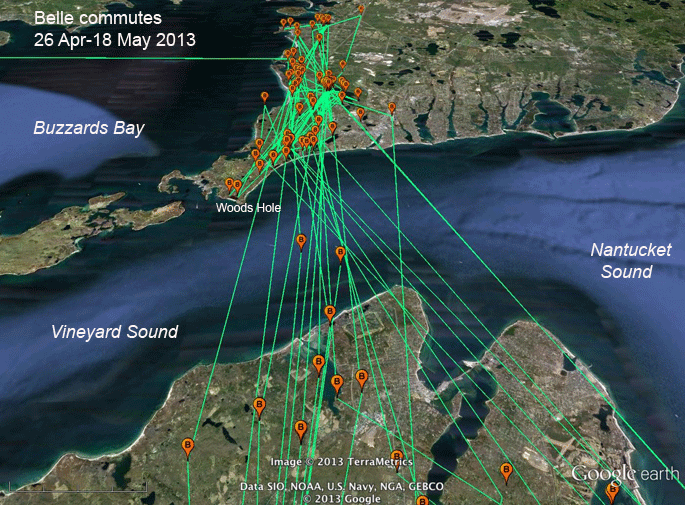 |
26 Apr - 18 May 2013 -
Belle is a pretty regular commuter between Cape
Cod and Martha's Vineyard-a crossing of only
about 4.5 miles. Since she returned on Apr 26th,
she's made 10 round trips. Makes me wonder if the adults on the Vineyard's north shore are fishing over on the Cape. |